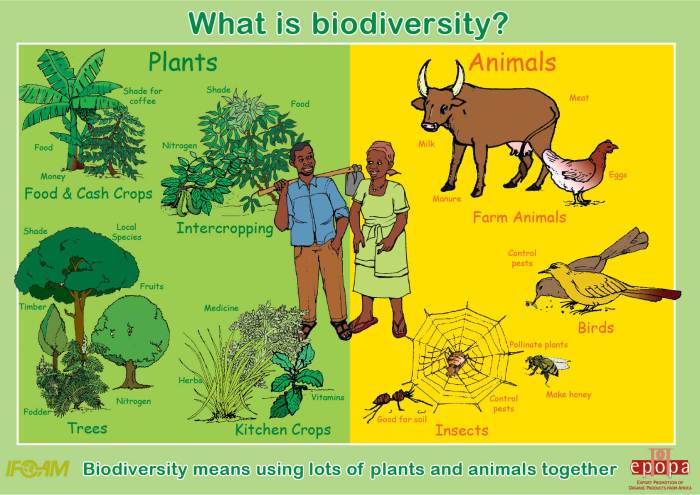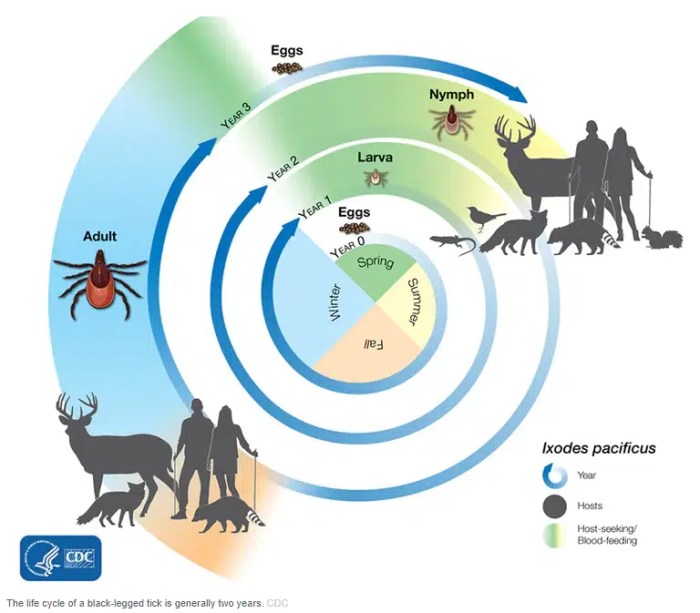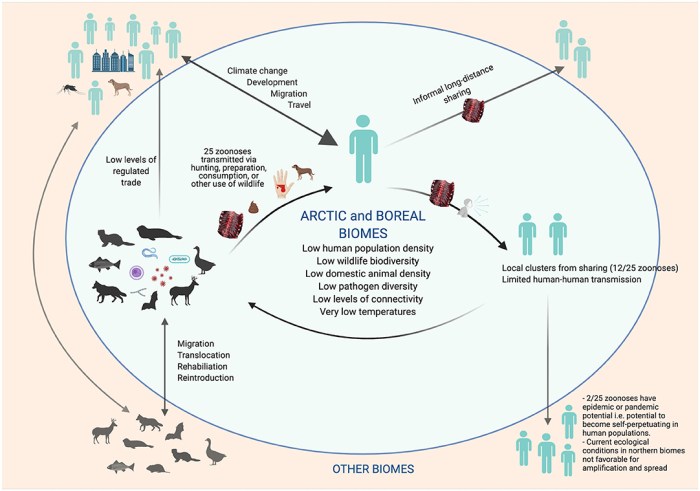How biodiversity can repel and combat ticks is a fascinating topic with significant implications for human health and the environment. It’s not just about keeping ticks at bay; it’s about understanding the intricate web of life and how it influences the delicate balance of ecosystems.
This complex interplay between biodiversity and tick populations reveals a natural defense mechanism against these pesky parasites.
Imagine a diverse ecosystem teeming with life. Here, the presence of a wide range of plant and animal species creates a natural barrier against ticks. Predators, like birds and small mammals, actively hunt and consume ticks, while parasitoids, like certain insects, lay their eggs inside ticks, ultimately killing them.
The diverse plant life also plays a crucial role, offering habitat for predators and providing natural repellents that discourage ticks from settling.
Biodiversity and Tick Ecology

Biodiversity plays a crucial role in regulating tick populations, acting as a natural defense against these disease-carrying parasites. A diverse ecosystem provides a complex web of interactions that can limit tick abundance and distribution.
The Influence of Biodiversity on Tick Populations
A diverse ecosystem offers a variety of habitats and food sources for various organisms, including natural predators of ticks. This diversity creates a balance within the ecosystem, preventing any single species, including ticks, from dominating.
Examples of Species Impacting Tick Populations
- Predatory Animals:Animals like birds, reptiles, amphibians, and even some mammals prey on ticks, helping to control their populations. For example, birds like the American robin and the eastern bluebird are known to consume ticks, particularly during nesting season.
- Tick Parasites:Certain parasites, such as mites and protozoans, can infect and kill ticks, reducing their numbers. These parasites often thrive in diverse environments, where they can find suitable hosts.
- Plants:Some plants release chemicals that repel ticks or disrupt their life cycle. For instance, certain species of mint, lavender, and rosemary have been shown to have tick-repelling properties.
The Impact of Habitat Diversity
Habitat diversity provides a range of microclimates and resources, influencing the distribution and abundance of ticks. For example, wooded areas with dense undergrowth and moist environments often support higher tick populations compared to open grasslands or dry habitats.
Predators and Parasitoids of Ticks

Ticks, while small, play a significant role in ecosystems. They are blood-feeding parasites that can transmit diseases to humans and animals. Fortunately, ticks have natural enemies that help control their populations. These enemies include predators and parasitoids.
Just like a diverse ecosystem can help control tick populations, a variety of plants in your home can help deter pesky houseplant gnats. Think about incorporating carnivorous plants like Venus flytraps or sundews, or even introducing beneficial insects like ladybugs, which are natural predators of gnats.
Houseplant gnat infestations can be a real nuisance, but by mimicking the natural balance of a diverse ecosystem, you can keep those pesky gnats at bay and enjoy a healthier, happier home.
Predators of Ticks
Predators are animals that actively hunt and kill other animals for food. Many different animals prey on ticks, including birds, reptiles, amphibians, and mammals.
- Birds: Birds are particularly important predators of ticks. They often forage in areas where ticks are abundant, such as grasslands and forests. Some bird species, like the American robin and the common grackle, are known to consume large numbers of ticks.
They are effective at finding and consuming ticks in various stages, including larvae, nymphs, and adults. This is due to their feeding habits, which often involve searching through leaf litter and vegetation where ticks are commonly found.
- Reptiles and Amphibians: Lizards and frogs also consume ticks. Lizards, particularly those that live in habitats where ticks are abundant, like the fence lizard and the western fence lizard, often feed on ticks. Similarly, amphibians like the American toad and the green tree frog are known to include ticks in their diet.
A diverse ecosystem, teeming with life, is a natural shield against pesky ticks. The presence of predators like birds, like the tiny but mighty hummingbirds, whose migration patterns often coincide with tick activity, helps to keep tick populations in check.
This delicate balance, where every creature plays a role, reminds us that biodiversity is not just beautiful, it’s a vital force in keeping our environments healthy and safe.
Their feeding habits, which involve hunting insects and other invertebrates, make them efficient predators of ticks.
- Mammals: Some mammals, such as shrews, moles, and bats, also prey on ticks. These small mammals often live in areas where ticks are abundant and consume ticks as part of their diet.
Parasitoids of Ticks
Parasitoids are insects that lay their eggs on or in other insects. The parasitoid larvae then develop inside the host, eventually killing it. Several parasitoid species attack ticks.
- Mites: Certain species of mites, such as the larval stage of the mite Varroa destructor, parasitize ticks. These mites attach to ticks and feed on their blood, weakening them and eventually killing them.
- Wasps: Some species of wasps, like the braconid wasp Ixodiphagus texanus, are known to parasitize ticks. The female wasp lays her eggs on or near a tick. The wasp larvae then develop inside the tick, feeding on its tissues. This eventually kills the tick and allows the wasp larvae to pupate and emerge as adults.
Biodiversity and Tick-Borne Diseases

Biodiversity plays a crucial role in regulating the transmission of tick-borne diseases. The presence of diverse plant and animal communities can influence the abundance and distribution of ticks, their hosts, and the pathogens they carry. This intricate interplay can either increase or decrease the risk of disease transmission, highlighting the importance of maintaining a healthy and diverse ecosystem.
Host Diversity and Disease Risk
Host diversity significantly impacts the transmission of tick-borne diseases. A diverse host community can dilute the concentration of pathogens within a population by spreading the infection across multiple species. This is known as “dilution effect.”
- For example, in areas with high biodiversity, ticks are more likely to encounter a variety of hosts, including those that are less susceptible to certain pathogens. This can reduce the overall prevalence of the pathogen within the tick population.
- Conversely, in areas with low biodiversity, ticks are more likely to feed on a limited number of hosts, which can lead to a higher concentration of pathogens within those hosts. This increases the risk of transmission to susceptible individuals.
Biodiversity and Disease Resistance or Susceptibility
Biodiversity can also influence the susceptibility of hosts to tick-borne diseases.
- For instance, the presence of certain plant species can provide natural protection against tick-borne pathogens. Some plants produce compounds that repel ticks or reduce their ability to transmit diseases.
- Conversely, habitat degradation and loss of biodiversity can increase the susceptibility of hosts to tick-borne diseases. This can be due to the loss of natural predators of ticks, the disruption of food webs, and the increased abundance of susceptible hosts.
Habitat Management for Tick Control

By carefully managing landscapes and promoting biodiversity, we can create environments less hospitable to ticks and reduce the risk of tick-borne diseases. Habitat management strategies aim to manipulate the environment to favor tick predators and reduce tick habitat, ultimately reducing tick populations and the transmission of diseases.
Impact of Land Use Practices on Tick Abundance and Disease Risk
Land use practices significantly influence tick abundance and the prevalence of tick-borne diseases. Intensive agricultural practices, urbanization, and deforestation can disrupt natural ecosystems and create favorable conditions for tick populations. For example, fragmentation of forests and the creation of open areas can increase the abundance of white-footed mice, a primary reservoir for Lyme disease.
Habitat Modifications for Tick Control
Several habitat modifications can be implemented to reduce tick populations and minimize the risk of tick-borne diseases. These strategies focus on promoting biodiversity, creating unfavorable conditions for ticks, and reducing tick host populations.
- Maintaining a Diverse Landscape:A diverse landscape with a variety of habitats, including forests, grasslands, and wetlands, supports a greater diversity of tick predators, such as birds, reptiles, and amphibians. This natural predator-prey balance helps regulate tick populations.
- Creating Tick-Resistant Habitats:By managing vegetation, we can create environments less favorable for ticks. This includes maintaining open areas with sunlight penetration and avoiding dense, shaded areas that provide ideal tick habitats. For example, clearing overgrown brush and fallen leaves in areas frequented by humans can reduce tick populations.
- Reducing Tick Host Populations:By controlling the populations of tick hosts, such as deer, mice, and other small mammals, we can reduce the overall number of ticks. This can be achieved through various methods, including deer fencing, habitat manipulation, and predator management.
Table of Habitat Modifications and Their Effects on Ticks
| Habitat Modification | Potential Effect on Ticks |
|---|---|
| Creating open areas with sunlight penetration | Reduces tick habitat by reducing humidity and shade. |
| Maintaining a diverse landscape with a variety of habitats | Supports a greater diversity of tick predators, which helps regulate tick populations. |
| Managing vegetation to reduce tick host populations | Reduces the availability of hosts for ticks, thereby reducing tick populations. |
| Planting tick-resistant vegetation | Reduces tick habitat by providing less favorable conditions for tick survival. |
| Controlling deer populations through fencing or other methods | Reduces the availability of deer, a primary host for ticks, thereby reducing tick populations. |
Biodiversity and Tick Repellents

Harnessing nature’s bounty to deter ticks is a promising avenue for tick control. This approach involves identifying and utilizing natural compounds derived from plants or other organisms that possess tick-repelling properties. These bio-based repellents offer a potentially safer and more sustainable alternative to synthetic chemicals.
Natural Compounds with Tick-Repelling Properties
Several natural compounds have shown promise in repelling ticks. These compounds are often found in plants, but some are also produced by insects or other organisms.
- Essential Oils:Many essential oils extracted from plants, such as peppermint, lemongrass, and eucalyptus, exhibit tick-repelling properties. These oils contain volatile compounds that can interfere with tick behavior, including their ability to locate hosts.
- Plant Extracts:Extracts from various plants, including garlic, rosemary, and cinnamon, have demonstrated tick-repelling activity. These extracts often contain a complex mixture of bioactive compounds that contribute to their repellent effects.
- Insect-Derived Compounds:Certain insects produce compounds that can repel ticks. For instance, the venom of the yellow jacket wasp contains a peptide known as “mastoparan,” which has shown tick-repelling activity.
Research on the Effectiveness of Natural Tick Repellents
Numerous studies have investigated the effectiveness of natural compounds in repelling ticks.
- Essential Oil Studies:Research has shown that essential oils like peppermint, lemongrass, and eucalyptus can effectively repel ticks. For example, a study published in the Journal of Medical Entomology found that peppermint oil applied to clothing significantly reduced tick attachment rates.
- Plant Extract Studies:Studies have indicated that extracts from plants like garlic, rosemary, and cinnamon can deter ticks. For instance, a study published in the journal Parasitology Research found that garlic extract applied to the skin of rabbits significantly reduced tick infestation.
- Insect-Derived Compound Studies:Research on insect-derived compounds, such as mastoparan, has shown promising results in tick repellency. Studies have demonstrated that mastoparan can effectively inhibit tick attachment and feeding.
Developing Bio-Based Tick Repellents, How biodiversity can repel and combat ticks
The potential for developing bio-based tick repellents from biodiversity is significant.
- Sustainable and Eco-Friendly:Bio-based repellents offer a sustainable and eco-friendly alternative to synthetic chemicals, reducing the environmental impact of tick control.
- Reduced Toxicity:Natural compounds are generally considered less toxic to humans and animals than synthetic pesticides, minimizing the risk of adverse health effects.
- Innovation and Discovery:Continued research and exploration of biodiversity hold promise for identifying new and effective tick repellents.
Final Review: How Biodiversity Can Repel And Combat Ticks

In conclusion, understanding the intricate relationship between biodiversity and ticks is essential for safeguarding human health and preserving the natural world. By promoting biodiversity through habitat restoration, sustainable land management, and embracing nature’s inherent defense mechanisms, we can effectively control tick populations and minimize the risk of tick-borne diseases.
Let’s strive to create thriving ecosystems where the balance of nature prevails, protecting us from the threats posed by these unwelcome parasites.